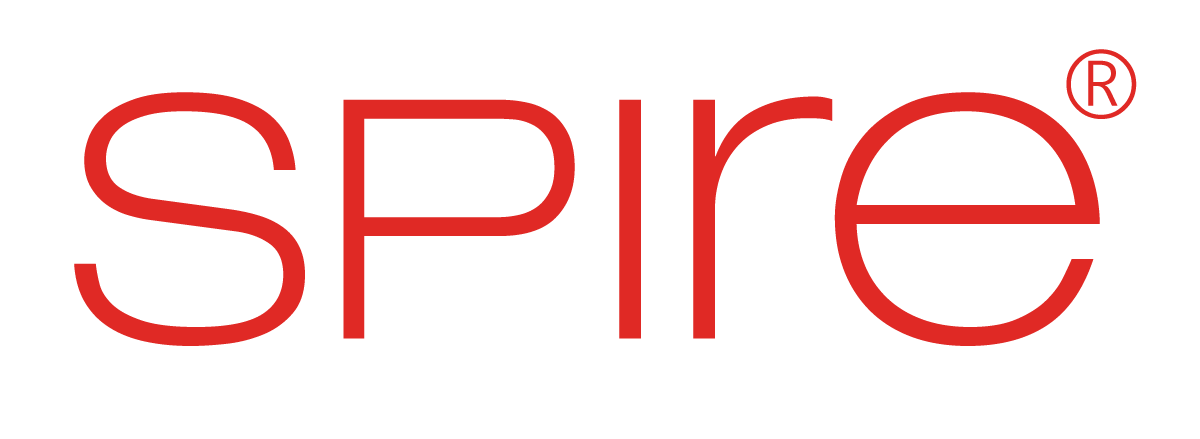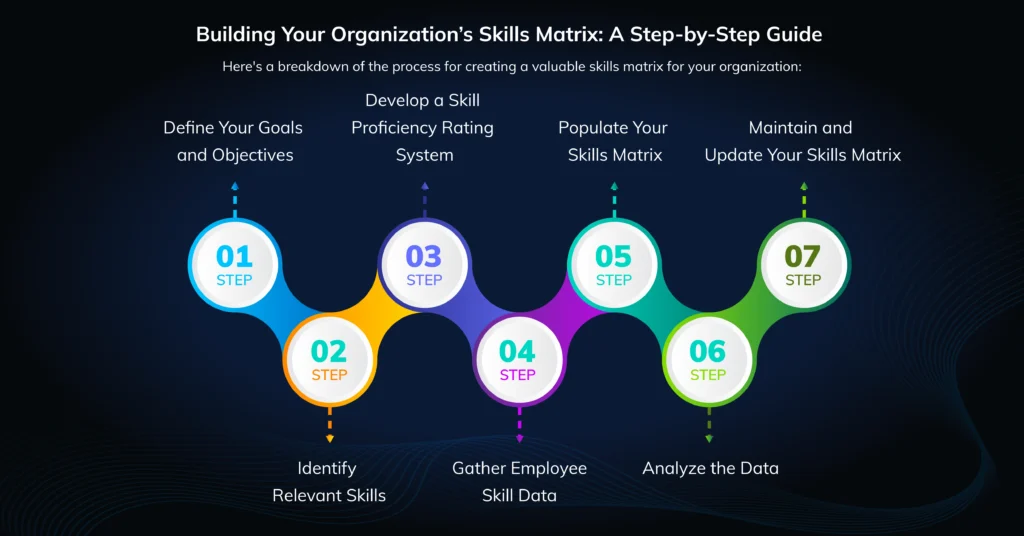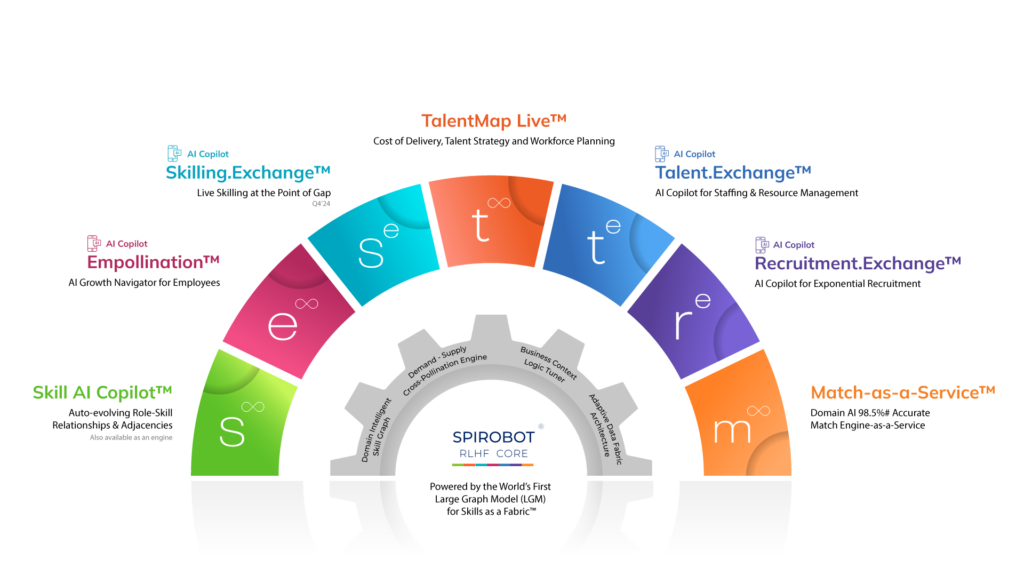In today’s dynamic business landscape, talent management is more crucial than ever. Organizations must stay ahead of the curve by ensuring their workforce possesses the right skill mix to thrive. A well-constructed skills matrix is a powerful tool that helps you clearly understand your employees’ capabilities and identify skill gaps. This, in turn, empowers you to make informed decisions about talent development, recruitment, and overall strategic planning.
This guide provides a step-by-step approach to building your organization’s comprehensive and practical skills matrix.
What is a Skills Matrix?
A skills matrix is a visual framework that maps employee skills against specific roles or departments. It typically includes details about the following:
What is a Skills Matrix?
A skills matrix is a visual framework that maps employee skills against specific roles or departments.
- Required Skills: This refers to the technical and soft skills needed to perform a particular role effectively.
- Employee Proficiencies: This indicates the level of expertise each employee possesses in a specific skill. This can be rated on a scale (e.g., Beginner, Intermediate, Advanced, Expert) or through a scoring system.
By analyzing this data, you can identify areas of strength and weakness within your workforce. This allows you to:
- Bridge skill gaps: Identify areas where employees need training or upskilling to meet the requirements of their roles.
- Optimize talent allocation: Match employees with projects and tasks that suit their skill sets best.
- Identify future leaders: Recognize employees with high potential and provide them with development opportunities.
- Inform recruitment strategies: Target recruitment efforts to fill specific skill gaps.
- Support career development: Provide employees with insights into their skill development needs and career paths.
Building Your Organization’s Skills Matrix: A Step-by-Step Guide
Here’s a breakdown of the process for creating a valuable skills matrix for your organization:
1. Define Your Goals and Objectives
Start by clearly outlining your goals for the skills matrix. Do you aim to identify skill gaps for a specific project, department, or organization? Do you want to track employee development over time? Having a clear purpose will guide the design and implementation of your matrix. Here are some additional questions to consider:
- What talent management challenges are you hoping to address? Are you facing high turnover, a skills shortage in a critical area, or difficulty filling open positions?
- Who will be the primary users of the skills matrix? Is it for HR professionals, managers, or employees themselves? Understanding the audience will help tailor the content and level of detail.
- How will the skills matrix be used? Will it be used for project planning, training needs identification or career development discussions?
2. Identify Relevant Skills
Brainstorm and categorize the essential skills needed for success within your organization. This includes hard skills (technical expertise) and soft skills (communication, teamwork, problem-solving). Consider including industry-specific skills as well. Here are some additional tips for identifying relevant skills:
- Review job descriptions and competency models: Analyze existing job descriptions and any established competency models to identify the skills required for various roles.
- Conduct stakeholder interviews: Interview key stakeholders, such as managers and subject matter experts, to gain insights into the critical skills needed across different departments and functions.
- Benchmark against industry standards: Research industry trends and reports to identify the skills in high demand within your industry.
3. Develop a Proficiency Rating System
Establish a transparent system for rating employee proficiency in each skill. This could be a simple scale (Beginner, Intermediate, Advanced, Expert) or a more detailed scoring system with numerical values. Ensure consistency in your rating system to avoid confusion. Here are some additional considerations for your proficiency rating system:
- Define clear criteria for each proficiency level: Outline the specific behaviors or skills that demonstrate each level of proficiency (e.g., Beginner – Can perform basic tasks with guidance, Advanced – Can independently complete tasks and troubleshoot minor issues).
- Consider using a weighted system: If certain skills are more critical for success in specific roles, you can assign them a higher weight in your rating system.
- Pilot test your rating system: Test your proficiency rating system with a small group of employees and managers to ensure clarity and ease of use.
4. Gather Employee Skill Data
There are various ways to collect data on employee skills. Here are some effective methods you can use:
- Conduct self-assessments: Employees can complete self-assessment surveys where they rate their proficiency in different skills.
- Skills surveys: Design skills surveys that ask employees about their experience, knowledge, and abilities in specific areas.
- Performance reviews: Integrate skills assessment into your performance review process.
- Skills demonstrations or tests: Consider conducting practical demonstrations or skills tests to evaluate proficiency for specific skills.
- Utilize existing data sources: Explore data from your HR information system, learning management platform, or employee portfolios to gather insights into employee skills.
5. Populate Your Skills Matrix
Organize your data in a clear and concise matrix format. List the required skills on one axis and employee names on the other. Use your chosen rating system to indicate each employee’s proficiency level in each skill. Here are some additional tips for populating your skills matrix:
- Use data visualization tools: Consider using spreadsheets with conditional formatting or data visualization tools to create a visually appealing and easy-to-understand matrix.
- Include additional information: You may want additional columns in your matrix for details like years of experience or relevant certifications.
- Maintain data privacy: Ensure you have the necessary permissions to collect and store employee skill data and follow data privacy regulations.
6. Analyze the Data
Once your matrix is populated, analyze the data to identify key trends and insights. Look for areas where there are skill concentrations or gaps. Use this information to inform your talent management strategies. Here are some specific questions you can ask while analyzing your skills matrix data:
- Are there any critical skills that need to be added across the organization? If so, you may need to develop training programs or implement recruitment strategies to address these skill gaps.
- Do certain departments or teams have specific skill weaknesses? This can help you tailor training initiatives or identify opportunities for cross-functional collaboration.
- Are there employees with a high level of proficiency in skills that need to be fully utilized? This could be an opportunity for redeployment or upskilling these employees to take on new challenges.
- How do employee skills align with future business needs? Consider your organization’s strategic goals and identify skills critical for future success.
7. Maintain and Update Your Skills Matrix
A skills matrix is a living document. Regularly update it to reflect changes in employee skill sets, new roles, and evolving business needs. Here are some best practices for maintaining your skills matrix:
- Schedule regular updates: Determine a frequency for updating your skills matrix, such as annually or biannually.
- Encourage ongoing skill development: Promote a culture of continuous learning and encourage employees to update their skill profiles as they acquire new knowledge and experience.
- Integrate with other HR systems: For a more streamlined process, consider integrating your skills matrix with your HR information system or learning management platform.
By following these steps and best practices, you can create and maintain a valuable skills matrix that empowers you to make data-driven decisions about your talent management strategies. This, in turn, will help you build a future-proof workforce equipped to meet the challenges of your ever-evolving business landscape.
Spire.AI: Your AI Copilot for Building a Robust and Sustainable Skills Matrix
Building a robust and accurate skills matrix can be time-consuming and complex. Furthermore, it can be challenging to maintain for the best results.
Considering the complexities of creating and maintaining a practical skills matrix, Spire.AI emerges as a robust AI Copilot for talent management professionals.
By leveraging its cutting-edge Artificial Intelligence capabilities, Spire.AI can streamline and automate the creation of skill matrices.
Spire.AI, an AI Copilot for Talent, simplifies and automates the process by leveraging a Large Graph Model (LGM) for skills with more than 10m+ nodes in the skill graph.
Here’s how Spire.AI can be instrumental:
- Auto-Evolving Role-Skill Framework: Spire.AI automates the creation of a comprehensive skills framework that maps roles to required skills at various levels (beginner, advanced, expert).
- Automatic AI-generated Employee Skill Profiles: Spire.AI analyzes data from various sources to generate skill profiles for your employees, saving you significant time and effort.
- Real-Time Skills Gap Analysis: Spire.AI provides real-time insights into skill gaps within your organization, enabling you to make data-driven decisions about talent development and recruitment.
By integrating Spire.AI, you can create a skills matrix that becomes a strategic asset for your organization, empowering you to build a future-proof workforce.
Final Thoughts
Building a skills matrix is a valuable investment for any organization looking to optimize its talent management strategies. By following the step-by-step guide outlined in this blog, you can create a comprehensive and practical tool that provides a clear picture of your workforce’s capabilities.
Remember, a skills matrix is not a static document. Regular updates are essential to reflect your employees’ evolving skill sets, the emergence of new roles, and your business’s ever-changing needs. By fostering a continuous learning and development culture, you can empower your employees to broaden their skill sets and bridge any identified skill gaps.
This, in turn, allows you to build a future-proof workforce that is well-equipped to navigate the challenges and opportunities of the dynamic business landscape.
Considering the complexities of creating and maintaining a practical skills matrix, Spire.AI emerges as a robust AI Copilot for talent management professionals. By leveraging its cutting-edge Artificial Intelligence capabilities, Spire.AI can streamline the process, saving you significant time and resources.
Take the first step towards building a future-proof workforce. Explore Spire.AI today and unlock the potential of your talent!
Frequently Asked Questions
What is the skills matrix?
A skills matrix is a visual framework that maps employee skills against specific roles or departments.
How do you create a skill matrix?
To create a skills matrix, define your goals and objectives, identify key skills, assess employee proficiency levels, and map skills to job roles.
Why is the skill matrix important?
A skills matrix helps identify skill gaps, optimize talent allocation, and support career development planning. It is a valuable tool for workforce planning and succession planning.







